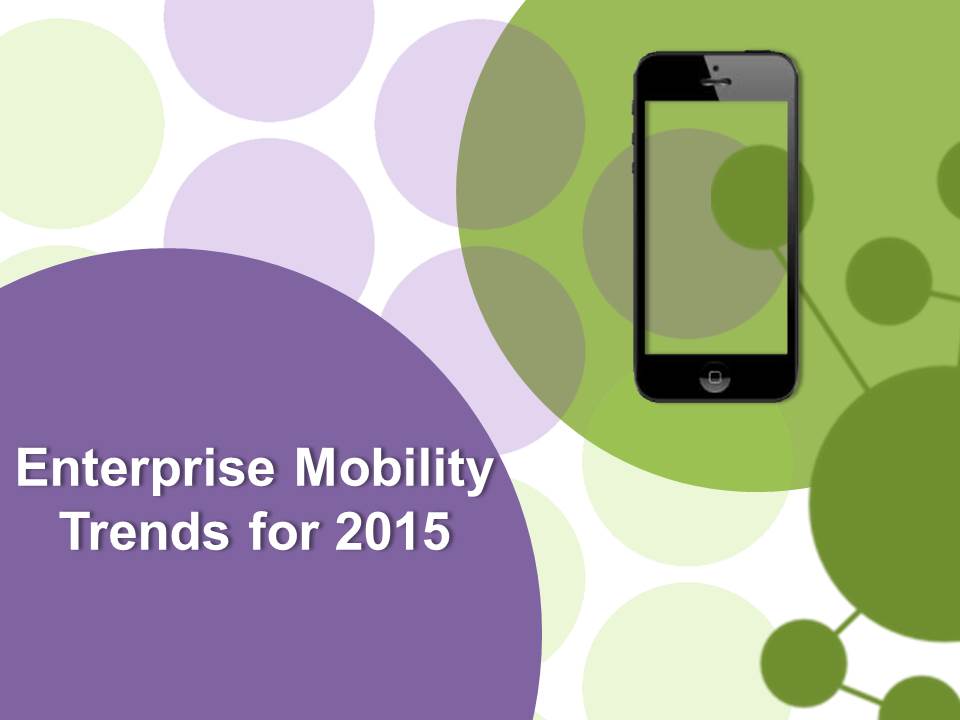
01 May Enterprise Mobility Trends for 2015
There are plenty of big trends in Enterprise Mobility heading into 2015.
The key standouts are a growing integration of Mobile Device Management (MDM), Bring Your Own Device (BYOD), and app development focused on a greater user experience.
The Growth of MDM
Businesses are continuing to take advantage of the benefits of Mobile Device Management. These include remote access to devices, restricting device usage through IT policies and pushing apps to devices in the fleet.
Airwatch by VM Ware as an example allows all devices across a fleet to be viewed and managed through a single console. It is available to all major operating systems and comes with a rich array of features.
Airwatch admins can access the following from the console:
- Device wipe, device lock and passcode reset
- Create new profiles
- Work Profile restrictions
- Disable the camera, copy/paste functions
- URL whitelists and blacklists
- Wi-Fi settings, including WPA2/WPA enterprise and certificates
- Google Email Client settings
- App-level controls, such as the ability to push apps automatically or on-demand
Airwatch has recently teamed with Android for Work to help separate work and personal use on devices. This helps to protect corporate data and empowers businesses to follow the BYOD model.
Making it Easier to BYOD
Bring Your Own Device (BYOD) is not a new practice for business however it is becoming increasingly popular. Whilst it is a cheaper and more convenient option for both businesses and users, it does not come without risks; namely security risks.
With the help of Mobile Device Management platforms BYO devices can be more safely managed. Solutions such as Android for Work or Airwatch, to name a few, work extremely well at keeping corporate data safe.
These kinds of platforms give the IT team more control over user activity, and if a device is lost it can be remotely wiped.
App Development for the User Experience
Customers care more than ever about the user experience when using mobile apps. Developers are trying to make apps and websites work seamlessly across all devices. This is achieved by either having scalable pages or by building independent versions for each kind of device.
Even Google recently made changes to its search engine algorithms to only display pages suited for mobile devices, when searching on a mobile device.
There is also the case of users pushing back on app developers who excessively request device information. This is usually collected by app developers to assist in marketing and advertising. Though app developers will find that in an increasingly competitive market users will lean towards safer, more private apps.
Analysing Big Data
With more data being collected than ever before businesses reap significant savings though data analysis. Looking closely at big data leads to more informed decision making. This leads to better efficiency in operations, a reduction in costs and fewer risks.
An impressive business case for the benefits of big data is by shipping giant UPS, as presented by SAS Institute. By collecting data from sensors in more than 46,000 vehicles UPS has managed to reduce costs by using software to reconfigure the pick-up and drop offs for drivers, in real time. As far back as 2011, this has saved UPS immense operational costs, including more than 31 million litres of fuel in 2011.
The major challenge for big data analysis is what data to analyse and how to maximise savings and better efficiency from the findings.
Mobile Payments Hit the Roof
The growth in mobile payment methods means transactions are easier than ever for customers. A 2014 report by Forrester predicts that US mobile payments will go from $52 billion in 2014 to $142 billion by 2014.
Apple and Samsung have both been pushing their mobile payment platforms with the release of their newest phones. Apple Pay and Samsung Pay allow customers to use the Near Field Communication (NFC) chip in their smartphone to authorize financial transactions. While Apply Pay is supported by up to 220,000 outlets in the US, Samsung Pay services more than 30 million terminals across the world.
Smartwatches and wearables are also utilising NFC technology making mobile payments more convenient.
Enterprise Mobility in 2015
As we move further into 2015 we expect to see a growth in MDM integration, an increase in BYOD and app development focusing on a greater user experience. While businesses will reap savings by analysing big data, customers are using mobile payment methods more than ever before.
If you would like to keep up with mobility trends and news please subscribe to our newsletter.




